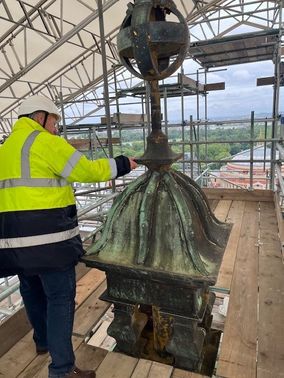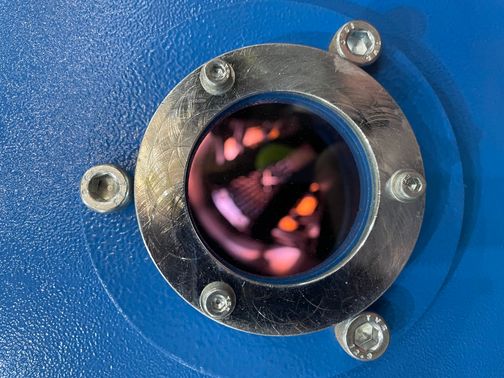High profile projects
De-steaming
A bold project removing a significant amount of legacy steam generating infrastructure from South Kensington Campus and upgrading what is one of the largest Low Temperature Heating System networks in London is nearing completion. Ultimately this will reduce Imperial’s carbon dioxide emissions by circa 2,400 tonnes/year and save over £1.341m per year after implementation, helping towards our 2040 net zero target.
Three new permanent boilers are being integrated into the heating and water network, allowing us to switch off two of the temporary boiler sites we have been relying on over the winter.
As well as the near switch over to the permanent boilers, we are also at the point where all steam has been removed from the buildings.
We will soon begin decommissioning temporary services and removing these from campus, which will visibly start to return to normal as a result.
See the latest news article on our webpages.
Net Zero decarbonisation programme
This ambitous programme supporting Imperial's Net Zero by 2040 targets is getting underway.
Arup report Our journey to a net zero estate by 2040
Energy saving lighting installation
To reduce carbon emissions the first action necessary is to reduce demand – and in the most cost-effective way.
Under the de-carbonisation programme we have drawn up, that means saving power on lighting, through making the switch to LED.
While our new-builds are fitted with LEDs, and as we’ve refurbished in other areas we’ve upgraded, we are embarking on the first series of interventions carried out without it being part of other work.
Please see the tab below for more information.
Solar panel installation
Silwood Park operates controlled-environment chambers that are used primarily for growing plants and insects, including chambers with temperature, humidity, and light control. Facilities include greenhouses, controlled environment rooms, a Fitotron and smaller incubators.
These energy hungry research facilities are to benefit from our first solar panel installation. All power generated by the installation to be used by the building.
Look out for more details of our programme.
Queen's Tower
The repair and restoration of the iconic Queen's Tower, the much-loved symbol of Imperial is continuing.
Click on the tabs below for more details.
You can view Fact Sheets, campus project plans and programmes currently being worked on here at Imperial. For information on individual projects, please open the project's fact sheet below.
Current projects
- Repairing the Queen's Tower
- Campus programmes and plans
- Decarbonisation of SK Campus
- Arup decarbonisation programme
- Energy saving upgrades
Queen's Tower restoration
At the heart of our South Kensington Campus the Queen’s Tower, which is more than 140 years old, is the last remaining part of the original Imperial Institute building. Repairs are required to the masonry and the copper roofing is being replaced.
The scaffolding will provide access for a full survey of the tower and for the comprehensive cleaning of the stonework. Once it has been cleaned, the detail repairs to the stonework will be confirmed and undertaken. The opportunity will also be taken to replace the timber louvres around the bell chamber and to repair or replace the flat roofs to the balconies.
The length of scaffolding being erected around the Queen’s Tower is 60km. This would stretch from South Kensington to our Silwood Park campus via White City, St Mary’s, Charing Cross, Hammersmith and the Chelsea and Westminster hospital campuses if the scaffold tubing were laid end-to-end.
The perimeter hoarding, the loading bay that you see, along with protocols for noise management will help minimise the disruption to the campus.
When the scaffolding is dismantled the stone steps and plinth will then be repaired.
The works are now scheduled to complete in January 2026, while every effort to bring that forward will be made.
This project will provide at least 50 years of further life to the external fabric of the highly visible icon of Imperial.
You can download details of the project from the highlight button on this page.
Read more about the restoration work in People, Places, Spaces magazine.
Watch the latest time lapse of the scaffolding as it reaches the top of the Queen's Tower
Watch the work underway on the tower on YouTube.
A time lapse video of work up until March 2023
Watch a time lapse video of work on the tower until April 2023
Current visible projects on South Kensington Campus

Scaffolding is being erected for the repair and restoration of the Queen's Tower

The viewing porthole with the flame alight in the 10-megawatt new boiler in the Energy Centre
As part of Imperial’s journey to Carbon Net Zero by 2040, the Silwood Park campus has become a key location for solar panel installation.
Silwood Park is located just outside of London, near the appropriately named village of Sunninghill. The centre is surrounded by 100 hectares of natural parkland, and focuses on research into evolution, biodiversity and conservation.

Genomics lab at Silwood
The Silwood installation consists of 86 solar panels that will help provide power for the campus’s Controlled Environment Rooms. It's estimated the panels will supply over 32,000 kWh per year, which is enough to run 228 large TVs continuously for a year. When the solar projects at Silwood are completed during 2025/2026 they should be able to generate 11% of Silwood's electricity needs.
On the 20 February final connections were made, allowing the solar panels to be part of the electricity supply for the Silwood campus.
“Having now delivered several projects on Imperial’s Net Zero journey; this is another great example of how energy savings and reduction in carbon can be made across our portfolio of buildings.”
Rodney Coppard, Project Manager, Imperial College London
“As we set out in our Science for Humanity Strategy, Imperial has big ambitions to get to Net Zero for our campus heat and power by 2040 and be a sector leader in sustainability across the board. It’s great to see visible progress already through new solar at Silwood, alongside LEDs and better building controls at South Kensington. There is lots more to come as we plan to refresh our sustainability strategy, switch from gas to heat pumps and improve our sustainability practices over the coming years”
Harriet Wallace, Sustainability Director, Imperial College London
How do the solar panels work?
Solar panels are made up of photovoltaic cells which convert the energy in sunlight, into electricity. Each cell produces just under one Watt of power in full sunshine. In a solar panel, many photovoltaic cells are connected together, and then many solar panels are connected together to generate a useful amount of electricity.
The stronger the sunshine, the more power is produced, but solar panels can still produce electricity under cloudy skies as they can use light that passes through clouds that isn’t visible to humans.
The electricity produced by the solar panels is in the form of direct current (DC), but most appliances are designed to run off the alternating current (AC) that comes out of a plug socket. So a solar converter is used to do the conversion from DC to AC electricity.

Solar Panels at Silwoood Park
Decarbonising Imperial
Imperial's Net Zero journey aims to reduce Imperial’s net carbon emissions from campus heat and power to zero by 2040. The programme involves reducing direct emissions from burning fossil fuels, as well as indirect emissions, which are mainly generated by power stations supplying the university’s electricity needs. Reducing the demand for electricity will be one of the biggest steps towards reducing Imperial’s carbon emissions. The solar panels at Silwood are just one part of these efforts.
Learn more about our sustainability-related projects on the Sustainable Imperial webpage.
.jpg)